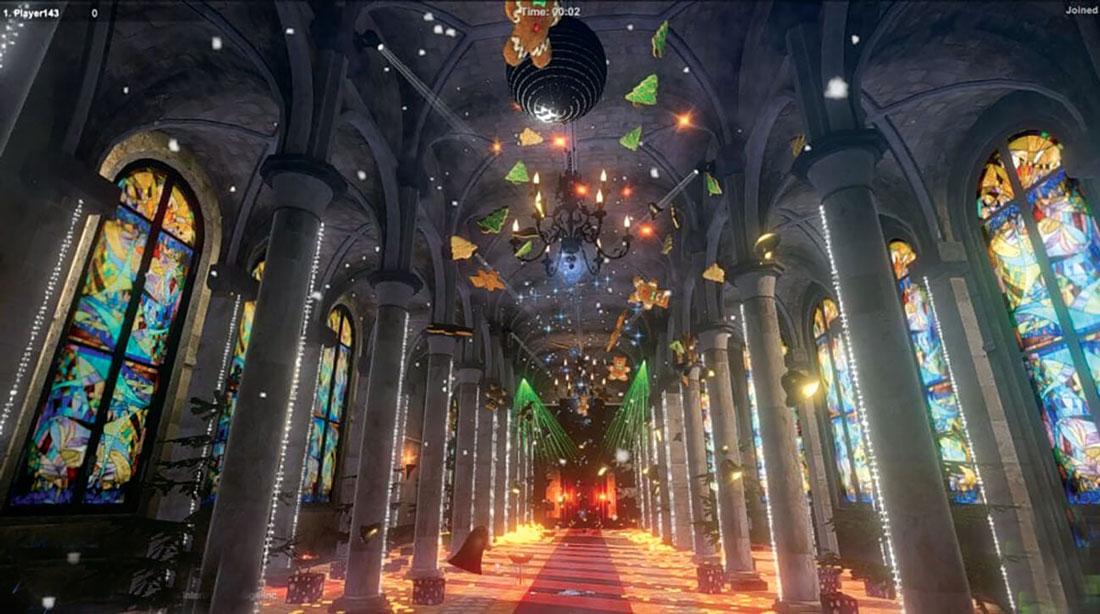Faith in the MetaverseBy Paula LaBrot | |
Faith in the MetaverseBy Paula LaBrot Religion is in the process of appearing in a Metaverse near you!
COVID-19 catapulted digital worship to the status of “new normal,” and there are many evolving spaces that are growing in popularity where people are able to commune spiritually with each other.” Virtual Reality (VR )and Augmented Reality (AR) are the current frontiers of spiritual life and practice.
Defining the Terms
According to Splunk.com, “Augmented reality and virtual reality are technologies that either enhance or replace a real-life environment with a simulated one. Augmented reality augments your surroundings by adding digital elements to a live view from some device. Virtual reality is a completely immersive experience that replaces a real-life environment with a simulated one.” With AR, the reality that appears on the screen of your device, like a smart phone, can be overlayed with new elements. For example, aim your phone at the sky and have all the constellations above you appear over your real image. In VR, you leap into a digitally constructed world. Both technologies allow a user to immerse themselves into environments where they can interact with people, objects and landscapes.
In virtual reality metaverse land, you can attend virtual worship services. You do it using an avatar, a character that represents you online. According to ABC News, “Bill Willenbrock, who leads a Christian fellowship on the social platform VRChat, with worship and counseling services for a flock of mostly teens and early 20-somethings…. [reported that] on a recent Sunday, he preached at a cavernous virtual cathedral, its long halls illuminated by light from stained-glass windows. A colorful assembly of avatars listened to the sermon: A giant banana sitting in the first pew next to another of a man in a shirt and tie, plus a mushroom, a fox and armored knights.” Curiouser and curiouser. |
A Little History
Ministries began using the radio to broadcast worship services in the early 1920s. Brooklyn Yiddish Radio ran from 1925-1946. Radio Ceylon had a religious and cultural dimension in its programming, broadcasting Buddhist, Hindu, Muslim and Christian programs starting in 1925.
In 1951, Archbishop Fulton Sheen brought his ministry to television and earned the title of first television evangelist. His show, Life is Worth Living, consisted of Sheen speaking to the camera and discussing moral issues of the day, often using blackboard drawings and lists to help explain the topic. A plethora of televangelists and televised religious worship programming followed right up to today.
In 2016, D.J. Soto, a high school teacher turned pastor, discovered the VR social platform, AltSpaceVR. According to ABC, “He was awakened to the possibilities of connecting in virtual reality. ‘The future of the church is the metaverse,’” Soto said. “It’s not an anti-physical thing. I don’t think the physical gatherings should go away. But in the church of 2030, the main focus is going to be your metaverse campus.”
The Rev. Jeremy Nickel, an ordained Unitarian Universalist, also saw the potential to build community and “get away from the brick and mortar” when he founded SacredVR in 2017, reports ABC. “Inspired by time spent in Nepal with Tibetan Buddhists and his alternative practices studies at seminary, Nickel began with secular meditations with the aim of being inclusive for all comers. But some religiously unaffiliated members of the community were put off by the name, he noticed, so he changed it to EvolVR and more people joined.”
The MetaCatholic project is a Catholic foray into the Metaverse, recognizing virtual reality and augmented reality as a new frontier. Father Ian VanHeusen suggests a parish could take people on a pilgrimage without leaving the country. Think about being immersed in religious history—attending the Sermon on the Mount with Jesus, attending a Medieval mass, or “sitting face to face with the Buddha, listening to him explain the Four Noble Truths, or perhaps celebrating Diwali by witnessing Krishna’s victory over Narakasura, or following Moses and Miriam as they lead you and others to freedom,” as suggested by Paul Brandeis Raushenbauch of the Interfaith Youth Core.
Wowie!
Keep Your Critical Thinking
Cap On!
The metaverse “clergy” are busy developing future platforms of worship. Coders are creating the new icons and places of worship. There is even an AI (artificial intelligence) program named “J.C.” that is creating content for the religious metaverse.
Raushenbauch reminds us, “Decisions about what Jesus will look like, what the Buddha will say, how Islam will be conveyed, the ethics of the Sikh tradition, will all be determined by people or programs far away from any given congregation, synagogue, or sangha, but who will directly affect how the people in those local spaces understand their tradition. If we think disinformation and misinformation on the internet is bad now, wait until it comes to us baked into the programming and presented in 3D.”
But then, haven’t people always created the images and writings of religions? Do we create ideas or are they given to us? Hmmm.
While there will be many opportunities for exploitation in the metaverse, Raushenbauch hopes that people from every spiritual and ethical tradition will be part of creating these new worlds to come so that they might be spaces of liberation and peace for an interfaith and ever-expanding circle of people, seeking to know one another and recognize our common humanity.
Vamos a Ver!   | | | | | | | | | | | | | | |
|
|
|
|
|
|
|
 |
|
|
|
| | |
|
|











